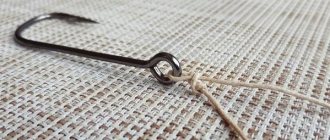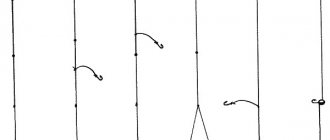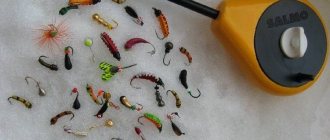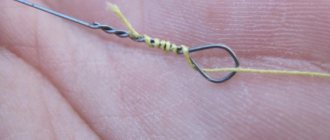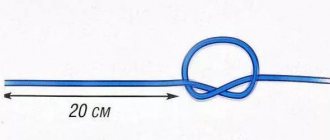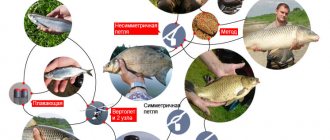Winter fishing is a hobby for millions of people, and each of its fans tries to come up with something new, somehow diversify ice fishing, and contribute to the common cause. Previously, fishermen could only offer the fish a hook with a bloodworm and a jig, then, thanks to fishermen’s imagination, rollers, garlands, drachiki and other cunning designs appeared, and now fishing with a balancer - a miniature artificial fish equipped with hooks on both sides - is in fashion.
Today there is already a large caste of fishermen, who are jokingly called balancers. The equipment of a winter fishing rod for fishing with a balance beam is aimed exclusively at predators. To effectively fish with it, you need to have certain skills. It is equally important to correctly assemble the tackle, which differs significantly from the usual balalaika for fishing for roach and small perch. What kind of fishing rod is needed for fishing with a balance beam in winter? Let's look at the tackle in detail.
Fishing rod
When buying a fishing rod for fishing with a balancer, first of all you need to pay attention to its strength, convenience, reliability of fastening the rings and the build quality in general. Carbon fiber is considered the ideal material for a whip. It is light and clear, unlike plastic, it does not become “wooden” in the cold and does not crack. It can only break if there is a large temperature difference, so you can’t immediately put a load on it. When leaving the car, it is better to wait about ten minutes until it cools down, and then start fishing.
The flexibility of the fishing rod is selected taking into account the weight of the bait. For example, if you intend to use small Rapala balancers, then it is advisable to choose a softer model for them. A rigid fishing rod almost does not bend when lifting a light bait upward, which is why it acquires an excessively frisky game. Sometimes this is good, but most of the time, smooth animation is effective.
Fishing with balance beams: typical mistakes
I would like to share my observations - what mistakes anglers often make when fishing with balance beams.
Many problems happen with the fishing line and its attachment to the bait. Recently I heard complaints from an angler who, for once, had a large perch bite on the balancer, but near the hole he broke off the fishing line... 0.1 mm. As they say, comments are unnecessary.
The thickness of the fishing line is optimal in the range of 0.18-0.22 mm, but the real section, and not what is indicated on the packaging. And the strength of the fishing line needs to be checked periodically, at least by hand.
A fishing line of this diameter breaks with great difficulty, when it already seems that your hand is about to be cut. A strong fishing line is needed not only to pull out large fish, although this is also important, but also to save the balancer when it gets caught on grass, shells, etc.
It's hard to resist the temptation to put on a leash - but you have to. It cannot but worsen the game of the balancer; the leash moves perpendicular to its axis and its entire length with thickenings at the ends, a clasp and a carabiner creates additional turbulence in the water.
Some people will ask: what if a pike bites? Alas, the duel will most likely end in favor of the toothy one; and the loss of the spinner has to be treated philosophically - as inevitable.
Unfortunately, many losses of lures occur due to the banal untying of a knot when playing a fish, and not from its teeth. The knot should be used only from those recommended in fishing literature. For example, a knot for tying summer lures is very reliable. And it’s important: the tip of the fishing line needs to be cut away from the knot, 8-10 mm. It doesn’t interfere with the game, but it won’t let the knot get untied.
Another problem is the assembly rubbing against the balancer arm. If a predator is caught on one of the side hooks, then when fishing for fish, a large distortion occurs at the place where the balancer is attached, as on a rocker with one full bucket. At the same time, the knot, overcoming friction, slides and moves to the edge of the bow. It constantly has to be corrected by moving it back; otherwise the spoon hangs crookedly, and its attractiveness in the eyes of the fish decreases.
If there are burrs on the bow, sooner or later the line on the knot will fray...
In order not to check the position of the knot after each fish caught (in the heat of the bite you simply forget about this), and in order to get rid of the “disease” of rubbing the knot, I solder a small oval ring made of copper wire to the bow of the balancer, and then tie the fishing line to it. Copper is a soft metal, burrs on the fishing line are not a problem, and the balancer always hangs evenly.
For the same purpose, many fishermen use small wire snap fasteners, usually sold with swivels. Although there are still debates whether such modernization does not worsen the performance of the bait, I think their use is quite justified, it immediately becomes easier to change the balancers. In the end, during the most capricious bite, the fastener can be removed by tying the fishing line directly to the spoon.
The question arises about the role of the swivel: supposedly it prevents the line from twisting. There are fishermen who specially tie a swivel for this purpose in a break in the fishing line, about forty centimeters from the balancer (so high that it does not affect the play of the spinner). From my point of view, such an improvement is unnecessary.
Observing the movement of the balancer in the water after swinging the rod, you can see that, having made a figure eight, it begins to rotate, unwinding the fishing line. But it is during this phase that most bites occur. This means that the fish like this rotation.
An important element of success is a bite alarm - a watchdog. It is puzzling the persistence with which some, usually already advanced, fishermen continue to flash a fishing rod without a guard, hoping to feel a bite with their hands.
I assure you that it is often only by a well-adjusted guard that it is possible to determine the hesitant touch of a predator on the spoon.
And the attack of the bait from below, when the guard straightens, cannot be felt at all without it.
Good guards are made from a flat metal plate of the required rigidity, for example, a clock spring. In stores they are sold covered with bright enamel. They are inexpensive, but a few finally noticed bites can ensure a catch. It’s a good idea to put a light plastic ball of an eye-catching color on the tip of such a guard.
Then all that remains is to follow with your eyes not the guard, but only this ball.
Now - about fishing technique. When fishing with balance beams, many still make two big mistakes. These are powerful strokes, as when fishing with a vertical spoon, and fishing only the bottom area. In fact, the strokes should be with a small amplitude, 5-10 centimeters at the tip of the guard.
However, one can welcome the variety of the game: individual swings with a large amplitude, continuous swinging of the spoon like a jig, including gradual lowering and raising of the tackle, etc.
You need to fish all tiers of the water space with equal persistence. The simplest technique is as follows. Rewind the line until the spoon touches the bottom. This immediately determines the depth of the place. Raising the bait slightly, make 10-12 strokes.
Rotating the reel, wind the fishing line 30-40 centimeters. Again 10-12 strokes. And so on until the ice. If bites occur at some depth, this place is fished with all the care and variety of game, but then the rise to the top must be continued.
You can fish in the same way, but gradually lowering the line, from the ice to the bottom.
Based on the analysis of the nature of the bites, the impression may arise that the perch rises from the lower layers of the water following the playing balancer, and only suspecting that the potential prey is about to escape does it attack. At least, if you start playing on a new hole from the depth at which there were bites before, then bites are unlikely to happen right away. But having fished a couple of tiers up or down, you can hope for a well-deserved grip from a predator.
S. Chetvertkov
Coil
All existing types of reels are applicable for such gear: inertial, inertial-free, multiplier. Each of them has certain advantages and disadvantages, so the choice should be approached seriously and responsibly:
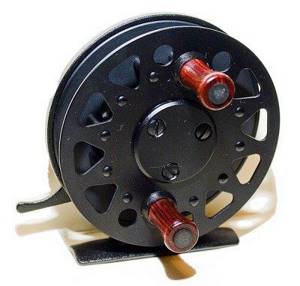
Inertia coil. The main advantage is the open drum, which allows you to visually control the supply of fishing line and ensure that loops and knots do not form on it. If desired, you can choose a mechanism equipped with a ratchet brake and a line release key. The size of the reel should not be unreasonably large, the inner diameter of the drum should not be more than 70 cm. A small winter fishing rod does not need extra weight.- Inertia-free. It’s not for nothing that this reel is called a meat grinder. It really “threshes” and works flawlessly, but in winter it will require special winter lubricant. A huge advantage of inertia-free fishing is that you can take several removable spools with fishing line of different diameters for fishing and quickly change them if necessary.
- Animator. It goes harmoniously with a winter fishing rod, but costs an order of magnitude more. To save money, you can order a Chinese product online, but the correctness of this choice is highly questionable. A cheap reel can present an unpleasant surprise, namely, jamming while landing a trophy fish. As a rule, in this case a break occurs. Another disadvantage of the multiplier is limited access to the spool.
Diameter
The thickness of the fishing line for the balancer is determined by the weight and size of the bait. Accordingly, when fishing at great depths with large baits, the diameter of the line on the balancer is required to be larger than when fishing for perch in shallow water with ultra-light nodless tackle. Approximate correspondence to the diameter of the baits used:
- Mini balancers 2-2.5 cm long – fishing line 0.12-0.14 mm;
- Up to 5 cm – 0.14-0.2 mm;
- 5-6 cm – 0.16-0.25 mm;
- 7-9 cm – 0.2-0.35 mm.
Of course, this is not a rule, but a trend. The smaller the bait, the thinner the tackle. Thickening worsens the performance of the bait. The boxes of branded balancers often indicate the recommended diameter of the fishing line. And this is not just like that. Serious manufacturers test the performance of their baits in special containers with water before putting them into production. The correct binding of the balancer and its position in the water is a separate topic, which is the subject of a special article.

Balancers
The task of the balancer is to interest the predator, provoke it to attack, and for this it must at least play interestingly and believably imitate a live fish. Some winter fishermen do not trust factory products, so they make such bait themselves. But with today's diversity, this is not particularly necessary. In fishing stores you can find a variety of balancers: plastic, silicone, narrow-nosed, with an enlarged head, with soft feathers, with a stabilizer, combined. Let's look at the three most common types:
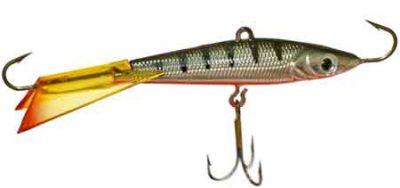
The classic balancer with a triangular feather is a perfectly balanced bait. Working position – horizontal (deviation of 5 degrees is allowed). The nature of the animation largely depends on the shape of the nose (front).- A balancer with a soft tassel tail is a perch option, although bites from pike perch and pike are also possible. Most often used in shallow waters to catch small striped predators. With a sharp swing, this type of balancer can turn upside down, so a calmer and smoother play is recommended for it.
- A silicone balancer is a specific bait that helps out on days when the fish are inactive. They need to play the same way as with a jig. A slow rise with a slight tremor will stir up any sleepy predator.
How to tie a balancer to a fishing line directly?
You can tie the balancer to the fishing line using popular fishing knots. This is “Palomar” or “Clinch”.
How to knit a Palomar knot . The Palomar knot is knitted as follows:
- the fishing line, folded in half, is pulled into a ring for attaching the balancer.
- then a simple knot is tied on it, but not tightened.
- The bait is passed into the loop formed from the double fishing line.
- All that remains is to carefully tighten the knot and trim the excess end of the fishing line.
That's it, the Palomar node is ready.
However, despite its simplicity, some anglers do not like it; they prefer the Clinch.
How to tie a Clinch knot. The Clinch knot is knitted like this:
- the end of the fishing line is inserted into the balancer ring;
- 5–7 turns are made around the main line;
- the free end of the fishing line is threaded into the resulting loops near the eye of the bait;
- the knot is carefully tightened.
For those who are not sure of the strength of a simple “Clinch”, we can suggest trying another version of this knot, which is called “Double” or “Improved” . It is performed in the same way as described above, only first the free end of the fishing line is folded in half.
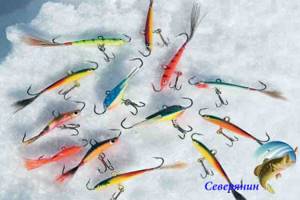
Winter fishing with a balance beam is very popular today, and I must say that this is a very catchy method of fishing. In order for the game with the balancer to be successful and correct, for the balancer to attract fish, the fisherman needs to know some of the nuances of attaching the balancer itself to the fishing line, for example, what knots are used to attach the balancer. Let's look at these features in more detail.
What are the requirements for installing a balancer on a fishing line?
To properly secure the balancer to the fishing line, there are a number of specific requirements, which will directly determine the catchability and effectiveness of the balancer.
Among the main requirements, the following, the most basic of them, can be identified:
- — when securing the balancer, all knots should not weaken the entire equipment;
- — when installing the balancer, the performance of the balancer itself should not deteriorate;
- — among other things, the entire mount must fully ensure the correct position of the balancer when playing;
- — you need to choose the right fishing line for fishing with a balancer.


